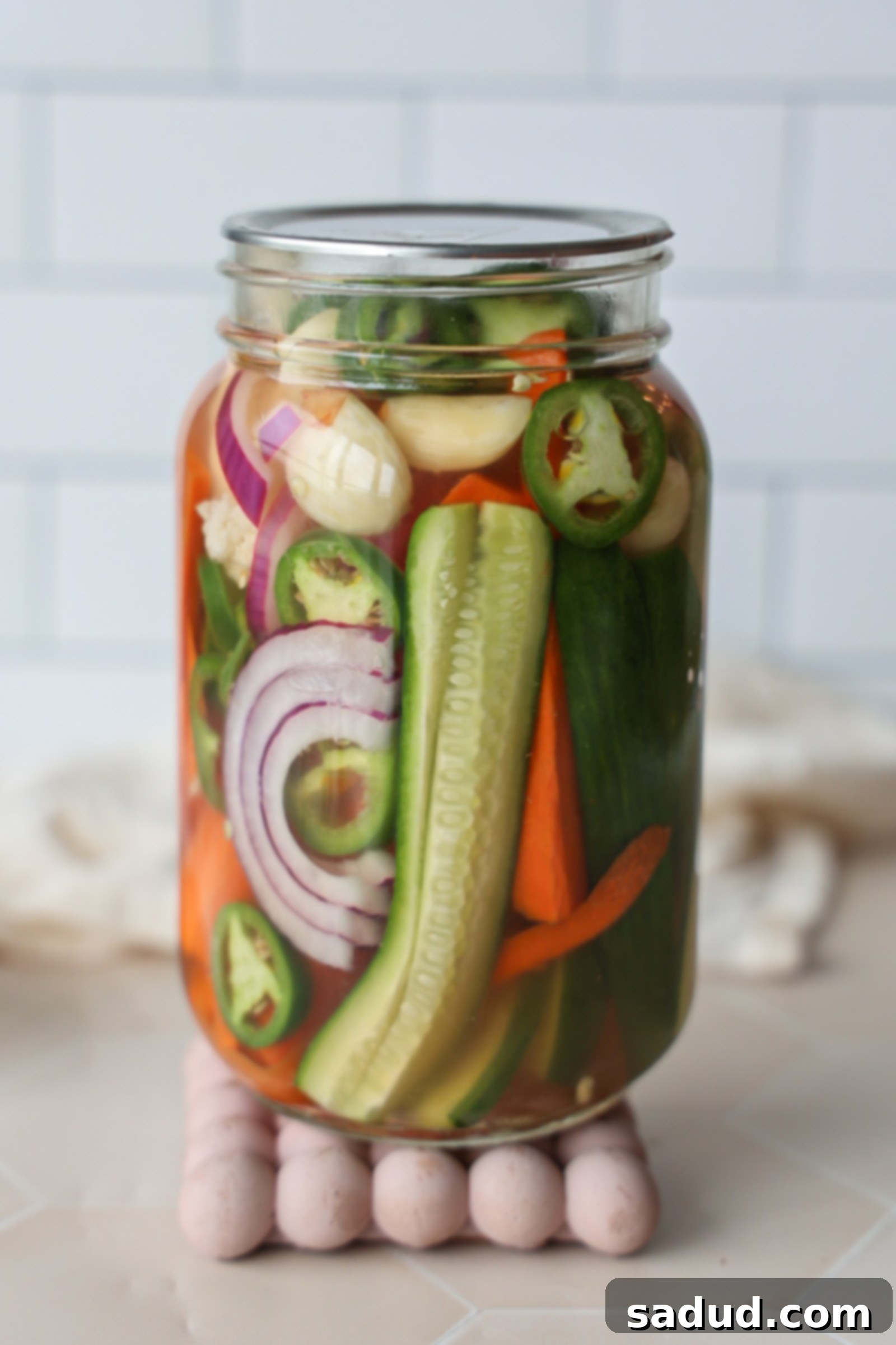Easy Homemade Quick Pickled Vegetables: Your Guide to Flavorful & Fresh Refrigerator Pickles
Transform your fresh produce into vibrant, tangy delights with quick pickled vegetables, also affectionately known as refrigerator pickles! These culinary gems are not only incredibly easy to make at home but also offer a fantastic way to preserve the bounty of your garden or local market, preventing food waste and extending the life of your favorite veggies. Whether enjoyed straight from the jar as a zesty snack or used to elevate the flavor profile of countless meals, these homemade quick pickles are a game-changer for any kitchen.
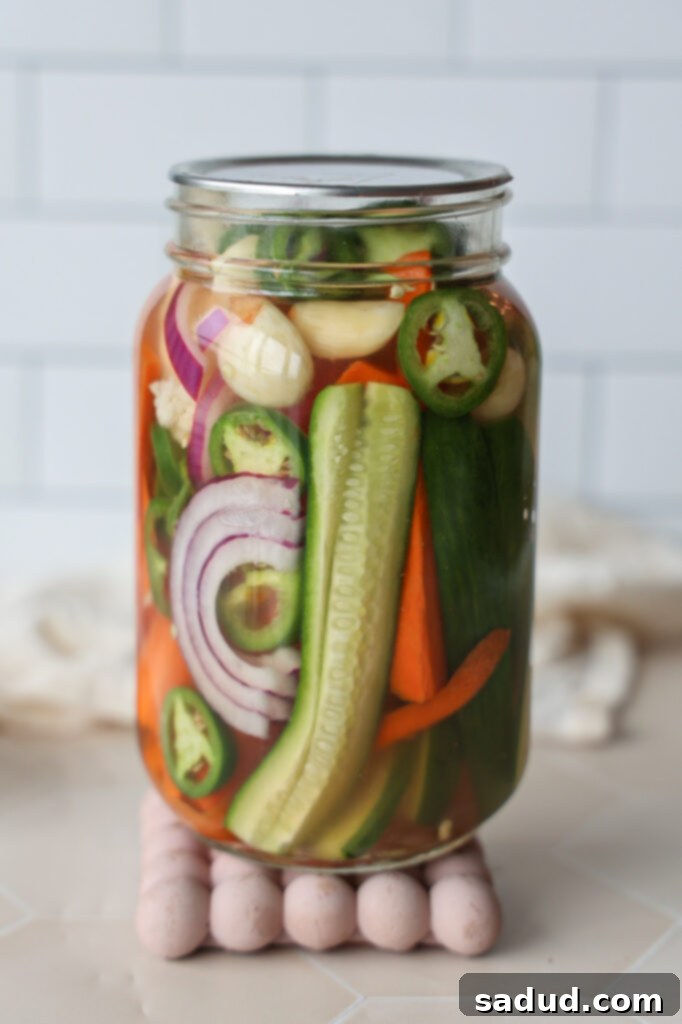
You’ve likely heard the buzz surrounding fermented and pickled foods, particularly concerning their impressive contributions to gut health. While the benefits of these foods are widely celebrated, they also bring an unparalleled depth of flavor to your culinary creations, making them an ideal salty, tangy addition to any dish or a satisfying snack on their own. You might be accustomed to purchasing fermented vegetables from specialty stores, but they often come with a hefty price tag and sometimes undesirable additives like excessive sugar or preservatives. The good news is, making your own pickled and even fermented foods at home is surprisingly simple and much more cost-effective!
It’s important to note that while often grouped together, fermenting and pickling are distinct techniques with different outcomes. Below, we’ll delve into the nuances of each method. However, this guide focuses specifically on quick pickling vegetables. This approach is significantly faster and serves as an excellent entry point for anyone curious about food preservation and flavor enhancement. If you’re eager to explore the fascinating world of true fermentation, this introductory guide offers a wonderful starting point.
Why You’ll Fall in Love with These Quick Pickled Vegetables
- Unbeatable Flavor Elevation: Quick pickles offer a delightful tangy, savory, and often slightly sweet kick that can transform an ordinary meal into something extraordinary. Their bright acidity cuts through rich flavors and adds a refreshing crunch.
- Incredibly Versatile & Eco-Friendly: This method is a fantastic way to utilize an abundance of fresh vegetables, especially those nearing the end of their prime. By pickling, you extend their shelf life significantly, reducing food waste and ensuring your produce stays delicious for longer.
- The Perfect Hostess Gift: Looking for a thoughtful and unique present? A beautifully jarred assortment of homemade quick pickled vegetables makes an exquisite hostess gift that’s both personal and incredibly tasty. It’s a delightful treat that shows you care!
- Customizable to Your Taste: Unlike store-bought options, making quick pickles at home allows you to control the ingredients, from the type of vinegar and spices to the level of sweetness and salt, ensuring they perfectly match your palate.
Understanding the Health Benefits: Fermented vs. Quick Pickled
While this article focuses on quick pickling, it’s worth briefly discussing the renowned benefits of truly fermented foods, as they are often conflated. Fermented vegetables are a phenomenal source of probiotics – beneficial bacteria that are crucial for a healthy gut and efficient digestion. The fermentation process itself can increase the bioavailability of certain vitamins and minerals, making them easier for our bodies to absorb. Research suggests that specific strains of probiotics found in fermented foods can positively impact mood, alleviate symptoms of anxiety and depression, support immune function, aid in weight management, and contribute to overall heart health. It’s truly amazing how these living foods can nourish us!
However, it’s important to clarify: quick pickles, or refrigerator pickles, are not fermented. They do not contain the live cultures or probiotics found in traditionally fermented foods because they rely on an acidic brine (vinegar) and refrigeration for preservation, rather than a lacto-fermentation process. While quick pickles offer incredible flavor and are a healthy addition to your diet due to their vegetable content and low calorie count, they won’t provide the same probiotic benefits as their fermented counterparts. Nevertheless, their culinary value and ease of preparation make them a staple in many kitchens!
What’s the Difference Between Pickling and Fermenting?
The terms “fermenting” and “pickling” are often used interchangeably, but they represent two distinct methods of food preservation and flavor development. While both can result in tangy, delicious foods, their underlying processes and health benefits differ significantly. Understanding this distinction is key to choosing the right method for your needs.
Pickling foods, specifically quick pickling (also known as refrigerator pickling), involves immersing food in an acidic liquid, typically a vinegar-based brine, to achieve a sour flavor. This method relies on the acidity of the brine to preserve the food and prevent spoilage. Quick pickling is a rapid process; the vegetables are ready to eat within hours to a few days and are stored in the refrigerator for short-term consumption (usually 2-3 weeks). The pickling liquid itself infuses the vegetables with flavor, but it does not introduce beneficial bacteria or undergo a fermentation process.
Conversely, when foods are fermented, their sour flavor arises from a natural chemical reaction. This process involves beneficial bacteria (lactobacillus, for example) breaking down the food’s natural sugars, producing lactic acid. This lactic acid acts as a natural preservative and gives fermented foods their characteristic tangy taste. No external acid (like vinegar) is required, although salt is usually added to control microbial growth and draw out moisture. Fermentation creates live cultures and probiotics, contributing to gut health. This method typically takes longer, from several days to weeks, and requires specific conditions (temperature, anaerobic environment) for successful fermentation. If you’re keen on the probiotic benefits, traditional fermentation is the path to explore.
For a deeper dive into the scientific and culinary differences, this article offers an excellent resource!
What Vegetables and Fruits Can You Quick Pickle?
While the classic cucumber pickle often comes to mind, the world of quick pickling extends far beyond! Many vegetables and even some fruits are incredibly well-suited for this method, allowing for endless creativity and flavor combinations. The key is to choose fresh, firm produce and prepare it appropriately for optimal texture and brine absorption.
Popular Vegetables for Quick Pickling:
- Radishes: Offer a peppery bite that mellows deliciously in brine, turning a beautiful pink hue. Slice thinly or halve.
- Red Onions: Become wonderfully tangy and lose their harshness, perfect for tacos, salads, and sandwiches. Thinly slice into rings or half-moons.
- Asparagus: Provides a crisp, bright addition to charcuterie boards or as a side. Trim tough ends.
- Carrots: Maintain a satisfying crunch and absorb the brine beautifully. Cut into matchsticks, rounds, or thin ribbons.
- Cauliflower: Small florets become tender-crisp and absorb flavors well. Chop into bite-sized pieces.
- Bell Peppers: Add a sweet and tangy element. Slice into strips or chop.
- Jalapeños: For those who love a spicy kick, pickled jalapeños are a must. Thinly slice into rings.
- Garlic Cloves: Whole cloves become surprisingly mellow and delicious.
- Turnips: Offer a unique earthy flavor and crisp texture. Slice thinly or dice.
- Green Beans: Dilly beans are a classic for a reason! Keep whole or snap into pieces.
- Beets: Transform into a vibrant, earthy, and tangy treat. Cook and slice, or pickle raw and thinly sliced for a firmer texture.
Did you know you can also quick pickle fruit? It’s a lesser-known but equally delightful application! Pickled fruits introduce a unique sweet and sour element to various dishes. Berries, peaches, apples, mango, pears, plums, and grapes all work exceptionally well. When pickling fruit, you’ll generally want to adjust the brine by increasing the sugar (e.g., to 4 tablespoons) and slightly decreasing the salt to balance the flavors. Pickled fruit can be a surprising and refreshing topping for ice cream, cakes, and pancakes, or even incorporated into your favorite cocktails or mocktails. They also pair wonderfully with savory dishes like roasted pork chops, rich curries, or added to a gourmet cheese board. The leftover fruit brine can even be a secret ingredient in homemade salad dressings!
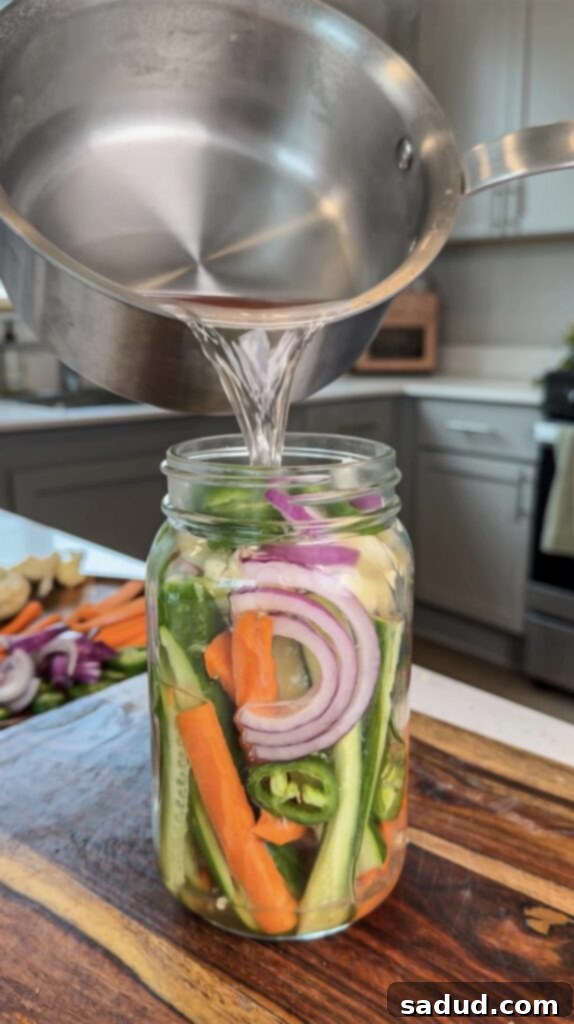
How to Make Quick Pickled Vegetables: A Simple Step-by-Step Guide
Making quick pickled vegetables at home is an incredibly rewarding experience, offering complete control over ingredients and flavors. Don’t hesitate to experiment with different vegetable combinations, vinegars, and spices to discover your personal favorites. The beauty of this recipe lies in its adaptability!
Ingredients & Essential Equipment You’ll Need for Quick Pickling:
- 1-quart wide-mouth mason jar: Or other glass jars/ceramic vessels. Wide-mouth jars make packing vegetables much easier. Ensure your jars are clean and sterilized for best results and shelf life.
- Whole Spices & Aromatics: This is where you can truly customize your pickles! While you can certainly use a pre-mixed pickling spice blend, experimenting with individual spices allows for endless variety. Some excellent choices include:
- Coriander seeds, fennel seeds, mustard seeds, celery seeds, black peppercorns (whole), allspice, clove, cumin seeds, dill seeds, star anise.
- Consider adding fresh aromatics like bay leaves, sliced ginger, or even a dried chili for extra heat.
- Vinegar: The backbone of your brine! A single type of vinegar or a combination will work wonders.
- White vinegar: Provides a classic, clean pickle flavor.
- White wine vinegar: Offers a slightly fruitier, more mellow acidity.
- Red wine vinegar: Will impart a darker hue to your brine and a richer flavor, great for beets or red onions.
- Apple cider vinegar: Adds a distinctive tangy, fruity note.
- Rice vinegar: Milder and slightly sweet, excellent for Asian-inspired pickles.
Tip: If you desire a clear, bright brine for aesthetic reasons, opt for clear vinegars like white vinegar or rice vinegar.
- Water: To dilute the vinegar and create the brine solution.
- Salt: Essential for flavor and a minor role in preservation. Always use non-iodized salt (e.g., canning salt, kosher salt, or sea salt) as iodine can turn vegetables dark and cloudy.
- Fresh Herbs (Optional, but highly recommended!): Elevate the flavor profile with fresh dill, cilantro, basil, oregano, or thyme sprigs.
- Sugar (Optional, but recommended for balance): A touch of sugar helps to round out the sharp acidity of the vinegar, creating a more balanced and palatable pickle. You can use any granulated sugar (white, brown, coconut sugar) or a sugar-free alternative like monk fruit sweetener for a sugar-free option, as I often do to keep these guilt-free.
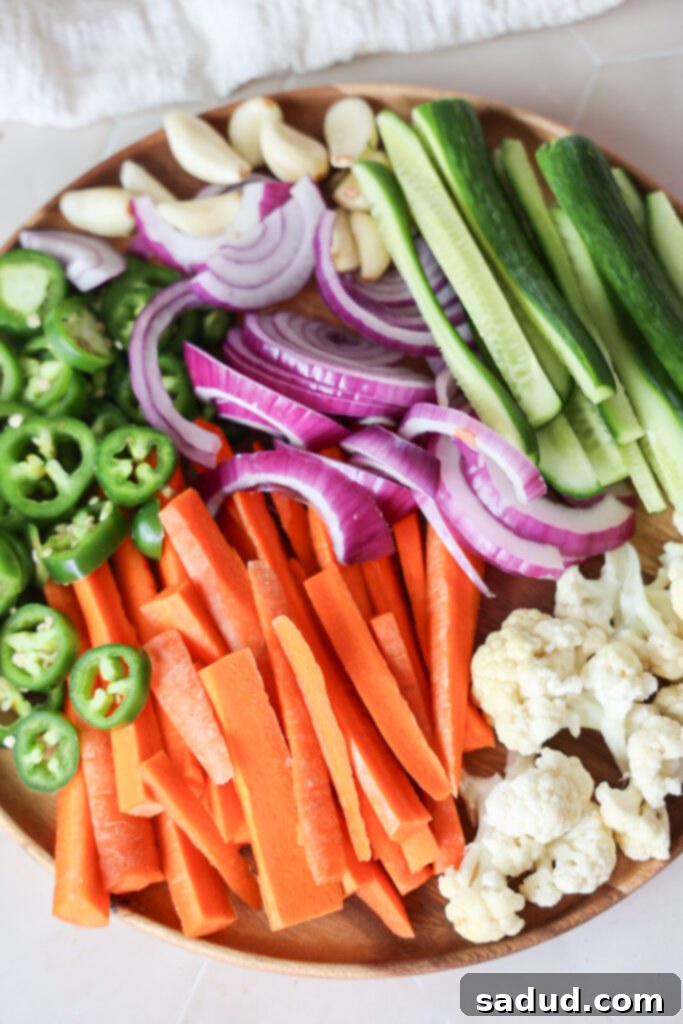
Simple Steps to Making Quick Pickled Vegetables:
Follow these straightforward steps to create your own batch of delicious refrigerator pickles:
- Prepare the Brine: In a small saucepan, combine your water, chosen vinegar, salt, and sugar (if using). If you’re using whole spices that you want to infuse thoroughly, you can add them to the brine at this stage. Bring the mixture to a rolling boil over medium-high heat, stirring until the salt and sugar are fully dissolved. Once boiling, remove the pot from the heat. This boiling step is crucial as it helps all the flavors meld beautifully and ensures a well-mixed brine.
- Prepare Your Jars and Vegetables: While the brine is heating, wash and thoroughly prepare the vegetables you intend to pickle. This involves cleaning, peeling (if necessary), and slicing or chopping them to your desired size and shape. Aim for uniform pieces to ensure even pickling. Pack your prepared vegetables tightly into your clean glass mason jars or ceramic vessels. Add any fresh herbs or additional aromatics (like garlic cloves or sliced jalapeños) directly into the jars with the vegetables.
- Combine and Let the Magic Happen! Carefully pour the hot brine over the packed vegetables in the jars, ensuring they are fully submerged. Fill the jars almost to the brim, leaving about 1/2 inch of headspace. It’s perfectly fine if you have some leftover brine; you can use it to make another small batch or simply discard it. Allow the jars to cool completely to room temperature on your countertop. Once cooled, seal them tightly with lids and transfer them to the refrigerator. For the best flavor development, wait at least one hour before enjoying your quick pickles, though overnight chilling will yield an even more pronounced “pickle” taste. The next day, your quick pickles will be extra cold, crisp, and wonderfully crunchy!
Frequently Asked Questions (FAQs) About Quick Pickled Vegetables:
- How long do quick pickles last in the fridge?
Quick pickled vegetables are best enjoyed within 2 to 3 weeks when stored continuously in the refrigerator. Unlike traditional canning, quick pickling is not a method for long-term, shelf-stable preservation. If you’re looking for pickles that can be stored in the pantry for months, you would need to explore proper canning techniques.
- Do I have to use sugar in quick pickle brine?
No, adding sugar to your quick pickle brine is entirely optional. However, a small amount of sweetener is highly recommended as it plays a crucial role in balancing the sharp acidity of the vinegar. It doesn’t make the pickles taste “sweet” (unless you add a lot), but rather enhances the overall flavor profile by providing a counterpoint to the sourness. In this recipe, we use just a touch of sweetener to achieve that perfect balance without making them overtly sweet. For a sugar-free option, monk fruit drops or other non-caloric sweeteners work wonderfully.
- How do you serve or eat quick pickled veggies?
The versatility of quick pickled vegetables is one of their greatest attributes! Here are just a few ideas:
- Straight Up: Enjoy them on their own as a refreshing and tangy snack.
- Salad Enhancer: Chop and toss them into green salads, grain bowls, or pasta salads for an extra burst of flavor and crunch.
- Sandwich & Wrap Filler: Layer them into sandwiches, burgers, hot dogs, or lettuce wraps to add a zesty element.
- Accompaniment: Serve them alongside any meal – they pair beautifully with rich meats, grilled dishes, or even simple eggs for breakfast.
- Snack Boards: A must-have on charcuterie boards, cheese boards, or appetizer platters.
- Creative Toppings: Surprisingly delicious on pizza, tacos, and even in scrambled eggs or omelets.
- Do you need to boil vinegar for pickling?
While you don’t absolutely *have* to boil the vinegar for quick pickling, it is highly recommended. Boiling the pickling solution serves several important purposes: it ensures that the salt and any sugar are fully dissolved, it helps to infuse the flavors from any added spices more effectively, and it slightly softens the vegetables, allowing them to absorb the brine more readily. The heat also helps to draw out some of the natural water from the vegetables, making them crispier. So, for the most flavorful and best-textured quick pickles, definitely boil your brine!
- Can I reuse the quick pickle brine?
It’s generally not recommended to reuse quick pickle brine for a new batch of vegetables, especially if the previous batch sat for a long time. Over time, the brine can become diluted by the vegetables’ natural water content, reducing its acidity and effectiveness for preservation. It might also pick up undesirable flavors or lose its potency. For the freshest, safest, and most flavorful results, always prepare a fresh batch of brine for each new jar of quick pickles.
Recipes That Would Taste Amazing with Homemade Pickles:
The bright, tangy crunch of quick pickled vegetables pairs perfectly with a wide array of dishes. Here are some fantastic recipes that would be wonderfully complemented by your homemade pickles:
- Thai Crunch Salad with Peanut Dressing
- Healthy Breakfast Bowls
- Salmon Nourish Bowl
- Copycat Sweetgreen Crispy Rice Bowl
- Cava Harissa Avocado Bowl
- Cauliflower Falafel Hummus Plate
- Vegan Nicoise Salad
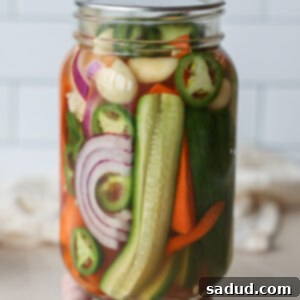
How to Quick Pickle Vegetables: The Ultimate Easy Recipe
Pin Recipe
Ingredients
Pickling brine
- 2 cups water (filtered is best)
- 2 cups vinegar (such as white vinegar, apple cider vinegar, or a mix)
- 1-3 tbsp sweetener, of choice *granulated sugar, liquid monk fruit, or maple syrup all work. Adjust to your taste!
- 2 tsp non-iodized salt (kosher salt or sea salt preferred)
- Optional spices: (e.g., 1 tsp mustard seeds, 1/2 tsp dill seeds, a few black peppercorns, 1 bay leaf)
Pickled Veggies (feel free to use whatever fresh produce you desire!)
- cucumbers, cut into spears or matchsticks
- red onion, thinly sliced into rings or half-moons
- carrots, cut into matchsticks or thin rounds
- garlic cloves, peeled (1-2 per jar)
- jalapeños, thinly sliced (for a spicy kick!)
- cauliflower florets, chopped into small, bite-sized pieces
Other Great Options for Pickling
- asparagus, green beans, beets, radishes, bell peppers
- Fresh herbs (e.g., dill sprigs, cilantro, thyme)
Instructions
-
Prepare the Brine: In a small saucepan, combine the water, vinegar, sweetener (if using), and non-iodized salt. If you’re using whole spices (like mustard seeds, peppercorns), add them to the pot now. Bring the mixture to a full rolling boil over medium-high heat, stirring occasionally to ensure the salt and sweetener are completely dissolved. Once boiling, immediately remove the pot from the heat.
-
Prepare Your Jars & Veggies: Thoroughly wash and prepare your chosen vegetables. Cut them into uniform pieces (matchsticks, slices, florets) that will fit well into your clean, wide-mouth glass jars or ceramic vessels. Pack the vegetables snugly into the jars. Add any fresh aromatics like garlic cloves, jalapeño slices, or fresh herb sprigs directly into the jars with the vegetables.
-
Pour Brine & Chill: Carefully pour the hot pickling liquid over the vegetables in the jars, ensuring they are fully submerged. Fill the jars up to about ½ inch from the rim. Don’t worry if you have some leftover brine – it’s better to have too much than too little. Let the jars cool down to room temperature on your counter. Once cool, seal them tightly with their lids and transfer them to the refrigerator. For the best “pickle” flavor, let them marinate for at least an hour, or ideally, overnight, before enjoying. They’ll be extra crisp and flavorful the next day!
Video
Notes
- How long do quick pickles last? These quick refrigerator pickles are fresh and delicious for about 2-3 weeks when kept consistently chilled in the fridge. Remember, this method is for short-term enjoyment, not long-term pantry storage. If you’re looking for pickles that last longer, you’ll need to research proper canning and heat-processing techniques.
- Do I have to use sugar in quick pickle brine? While not strictly mandatory, incorporating a small amount of sugar (or a sugar-free alternative like monk fruit drops) into your brine significantly enhances the overall flavor. It beautifully balances the acidity of the vinegar, preventing your pickles from tasting overly sour without making them sweet. Our recipe uses just enough to achieve this perfect harmony.
- How to serve/eat pickled veggies? The culinary applications for quick pickles are endless! Enjoy them as a standalone tangy snack, add a pop of flavor to salads, sandwiches, and grain bowls, or serve them as a vibrant side dish to any meal. They’re also fantastic on charcuterie boards, with fries, alongside eggs, and even on more adventurous dishes like pizza or tacos.
- Do you need to boil vinegar for pickling? Although you could use cold brine, we strongly advise boiling your pickling solution. Heating the brine ensures that the salt and any sweetener fully dissolve, and it helps the various spices and aromatics truly release and blend their flavors. This boiling step also slightly softens the vegetables, allowing them to better absorb the delicious brine, resulting in a more deeply flavored and perfectly crisp pickle.
- Can I reuse the quick pickle brine? For the best quality and safest results, it is generally recommended to use fresh brine for each batch of quick pickles. Reusing brine can lead to diluted flavors and reduced acidity, which compromises both taste and preservation effectiveness over time.
